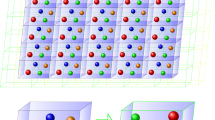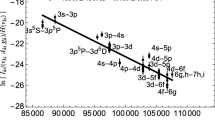Abstract
A perturbed angular correlation (PAC) experiment that measures dynamic damping also needs information about the fundamental quadrupole frequency to relate the damping as a function of temperature to the EFG fluctuation rate. When the experiment is unable to access slow electric field gradient (EFG) fluctuations that show the fundamental quadrupole frequency directly, one needs additional information to determine the hyperfine field parameters and thereby the connection between observed damping and EFG fluctuation rates. One way to solve this problem is to estimate the hyperfine parameters from the fluctuation rate for maximum damping (i.e. at the relaxation peak) or from the rate of maximum damping. This work relates both the maximum damping rate and the fluctuation rate at the relaxation peak to EFG magnitudes (or quadrupole frequencies) for five dynamic N-state symmetric models of fluctuating EFGs.
Similar content being viewed by others
References
Baudry, A., Boyer, P.: Approximation of the Blume’s stochastic model by asymptotic models for PAC relaxation analysis. Hyperfine Interact. 35, 803–806 (1987)
Lage, S., Collins, G.S.: Motion of cadmium tracer atoms in Al11 R 3 phases (R = La,Ce,Pr). Defect Diffus. Forum. 289–292, 755–761 (2009)
Winkler, H., Gerdau, E.: γγ-angular correlations perturbed by stochastic fluctuating fields. Z. Phys. 262, 363–376 (1973)
Dattagupta, S.: Study of time-dependent hyperfine interactions by PAC, Mössbauer effect, μSR and NMR: a review of stochastic models. Hyperfine Interact. 11, 77–126 (1981)
Evenson, W.E., Gardner, J.A., Wang R., Su, H.-T., McKale, A.G.: PAC analysis of defect motion by Blume’s stochastic model for I = 5/2 electric quadrupole interactions. Hyperfine Interact. 62(4), 283–300 (1990)
Guan, H.: Models of perturbed angular correlations in fluctuating electric field gradients. PhD dissertation, Brigham Young University (1994)
Lu, J.: Stochastic models of perturbed angular correlation due to diffusion of defects in materials. PhD dissertation, Brigham Young University (1995)
Zacate, M.O., Evenson, W.E.: Comparison of XYZ model fitting functions for 111Cd in In3La. Hyperfine Interact. 158(1–4), 329–332 (2004)
Zacate, M.O., Evenson, W.E.: Stochastic hyperfine interactions modeling library. Comput. Phys. Commun. 182, 1061–1077 (2011)
Marshall, A.G., Meares, C.F.: Effect of slow rotational diffusion on angular correlations. J. Chem. Phys. 56, 1226–1229 (1972)
Abragam, A., Pound, R.V.: Influence of electric and magnetic fields on angular correlations. Phys. Rev. 92, 943–962 (1953)
Author information
Authors and Affiliations
Corresponding author
Additional information
Supported in part by NSF grant DMR 06-06006 (Metals Program).
Rights and permissions
About this article
Cite this article
Park, T., Hodges, J.A., Moreno, C. et al. Relating PAC damping to EFG fluctuation rates through the PAC relaxation peak. Hyperfine Interact 199, 397–402 (2011). https://doi.org/10.1007/s10751-011-0332-6
Published:
Issue Date:
DOI: https://doi.org/10.1007/s10751-011-0332-6




